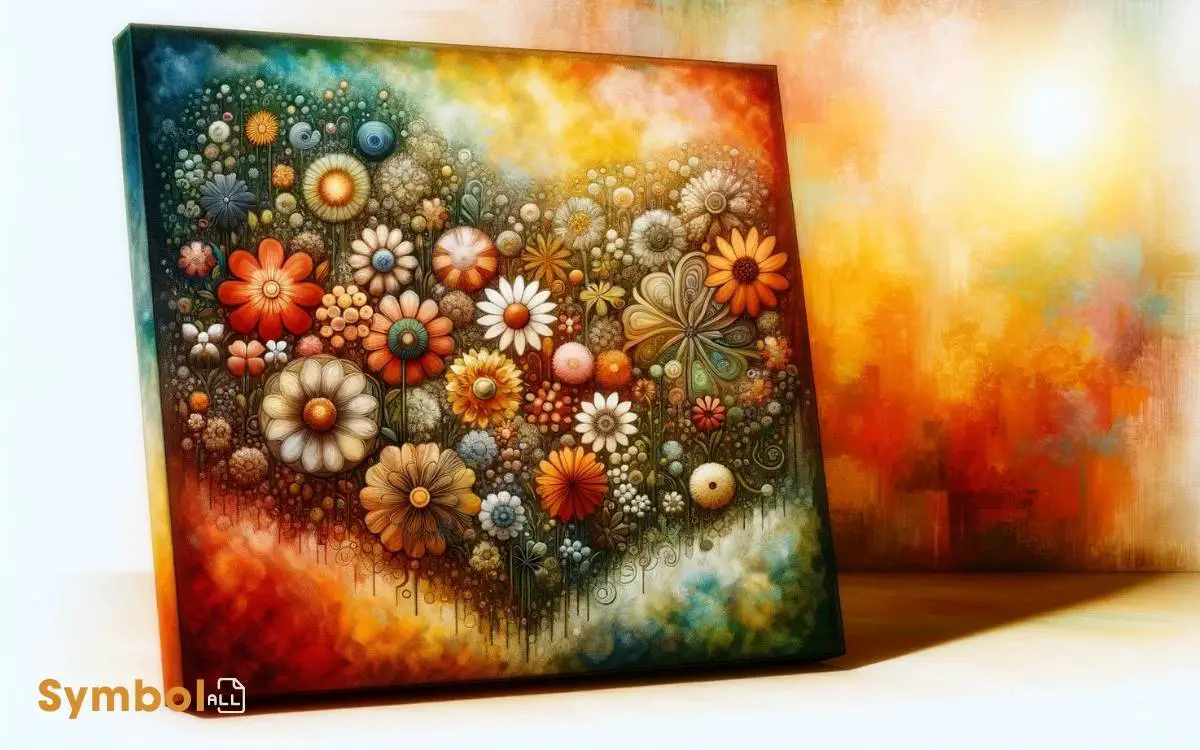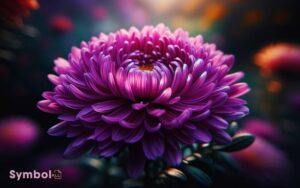What Does Flower Symbolize in Art? Emotions!
In art, flowers carry deep symbolic meanings, reflecting human emotions, societal values, and natural cycles. You’ll find roses conveying love and beauty, often encapsulating complex emotions and moral virtues.
Lilies, with their pure white petals, symbolize purity and mourning, offering solace and reflecting life’s transient nature. Sunflowers express adoration and loyalty, famously captured in Van Gogh’s vibrant works, symbolizing optimism.
Tulips portray the fleeting nature of fame, while orchids represent exotic beauty and luxury.
Each flower, from the modest daisy symbolizing innocence to the lotus embodying enlightenment, tells a story that transcends time and culture, inviting you to uncover deeper layers of meaning.

Key Takeaways
The Rose: Love and Beauty
Throughout history, the rose has consistently stood out as a symbol of love and beauty, deeply explore in various cultural narratives and artistic expressions. The rose’s rich symbolism transcends mere aesthetic appreciation, embodying complex emotions and virtues.
You’ll find that artists have long utilized the rose to convey messages of passion, devotion, and even the fragility of life.
Its depiction varies from the blooming rose, symbolizing full-blown love or beauty at its peak, to the wilting rose, indicating loss or the passage of time. This duality enhances the rose’s symbolic depth, allowing it to resonate with a wide audience.
Scholars and enthusiasts alike delve into the rose’s portrayal, uncovering layers of meaning that reflect societal values and individual experiences. Its enduring appeal in art underscores the universal human desire to represent and understand love’s multifaceted nature.
Lilies: Purity and Mourning
In the domain of symbolic flora, lilies stand as poignant emblems of purity and mourning, weaving complex narratives across various cultural tapestries.
You’ll often encounter these elegant flowers in artworks, where they’re not merely decorative but carry deep symbolic meanings.
Historically, the white lily, with its strikingly pure color and delicate form, has been associated with virginity and purity, making it a favored symbol in religious art, especially in depictions of the Virgin Mary.
Concurrently, lilies also encapsulate themes of mourning, their serene and unblemished appearance offering solace in grief and serving as reminders of the transient nature of life.
This duality enriches their portrayal, allowing artists to explore themes of innocence, loss, and the delicate balance between joy and sorrow.
Sunflowers: Adoration and Loyalty
As you explore the symbolism of sunflowers in art, you’ll find they’re not just a visual feast but carry deep meanings of adoration and loyalty.
Their prominence in Van Gogh’s work underscores a symbol of happiness, contrasting sharply with traditional symbols of mourning found in other florals.
The historical significance of sunflowers further enriches their role, offering a layered understanding of their presence across various art movements.
Sunflowers in Van Goghs Work
Van Gogh’s sunflowers consistently symbolize adoration and loyalty, weaving a rich tapestry of emotional depth into his artwork.
These vibrant blooms are not mere background elements; they are profound symbols that enrich our understanding of Van Gogh’s emotional and psychological state.
The sunflower series, in particular, reveals his complex relationship with these themes, offering insights into his personal quest for meaning and connection.
| Aspect | Significance |
|---|---|
| Color | Vibrancy and energy |
| Orientation | Facing the sun, optimism |
| Stage of Bloom | Cycle of life, impermanence |
| Number of Petals | Abundance, growth |
| Setting | Solitude vs. community |
Through these elements, Van Gogh’s sunflowers transcend their natural beauty, embodying his aspirations for adoration and loyalty amidst the challenges of his life and career.
Symbol of Happiness
Building upon the themes of adoration and loyalty, sunflowers in art also emerge as powerful symbols of happiness, reflecting an artist’s intent to convey joy and optimism through their vibrant hues and sun-facing posture.
You’ll find that artists use sunflowers to evoke a sense of liveliness and energy, ingeniously leveraging their natural characteristics to symbolize happiness.
- Vibrant Hues: The bright yellow of sunflowers symbolizes dynamism and vitality.
- Sun-facing Posture: Sunflowers turning towards the sun represent optimism and the pursuit of light.
- Universal Appeal: Their widespread recognition offers a direct connection to feelings of joy.
- Seasonal Symbolism: Sunflowers in bloom signify the height of summer, often associated with abundance and warmth.
This symbolic use enriches the visual and emotional layers of an artwork, inviting you to explore deeper meanings beyond the surface.
Historical Significance
Sunflowers, embodying adoration and loyalty, have held significant historical importance, deeply rooted in various cultures for their symbolic meanings.
These vibrant flowers, turning their heads to follow the sun across the sky, have become a metaphor for unwavering faith and devotion.
Historically, sunflowers weren’t just admired for their beauty but were revered for their alignment with solar symbols, representing life, fertility, and the cycle of rebirth.
In art, they’ve been depicted to symbolize the pursuit of light and truth, echoing artists’ adoration for enlightenment and loyalty to their craft.
This historical context enriches your understanding of sunflowers in art, revealing layers of meaning beyond their aesthetic appeal. Their portrayal isn’t merely decorative but a nuanced symbol of deep-seated virtues.
Tulips: Transience and Fame
In the domain of art, tulips often embody the fleeting nature of fame and the inevitable passage of time, serving as a poignant reminder of life’s transience.
This symbolism is deeply rooted in the flower’s historical context and its visual representation in various art forms. This symbolism is deeply rooted in the flower’s historical context and its visual representation in various art forms. Across cultures, the plumeria is often associated with themes of grace, beauty, and new beginnings, reflecting its delicate yet resilient nature. To understand its deeper meaning, one might explore its use in ceremonial traditions and religious practices, where plumeria flower symbolism explained ties it to concepts of immortality, devotion, and the eternal cycle of life. These rich layers of meaning make the plumeria a timeless emblem in both artistic and spiritual realms.
- Historical Context: Tulips’ popularity during the Tulipmania reflects the volatile nature of value and fame.
- Visual Metaphor: In still-life paintings, wilted tulips signify the temporary nature of beauty and success.
- Color Symbolism: The vibrant colors of tulips represent the spectrum of life’s experiences, from passion to decay.
- Cultural Significance: In different cultures, tulips symbolize perfect love and fame, highlighting their dual role in representing both the positive and ephemeral aspects of renown.
Orchids: Exotic Beauty and Luxury
Orchids have long captivated artists and collectors alike, symbolizing not just exotic beauty but also a luxurious lifestyle that transcends the ordinary.
These flowers, with their intricate shapes and vibrant colors, serve as a metaphor for rarity and opulence in art.
Historically, orchids were highly sought after by Victorian collectors, embodying the height of sophistication and the pursuit of beauty beyond the confines of the familiar.
In the domain of art, their depiction goes beyond mere representation; it invites the viewer to contemplate themes of desire, extravagance, and the human inclination towards the pursuit of perfection.
Artists leverage orchids’ diverse appearances to explore these themes, often positioning them as central figures in compositions that speak to the allure of the unattainable and the prestige associated with possessing such rare beauty.
Poppies: Sleep and Peace
Shifting focus from the opulent allure of orchids, poppies stand as symbols of sleep and peace, offering a stark contrast in their representation within the domain of art.
These flowers, with their delicate, papery petals and rich, somber hues, encapsulate a profound depth of meaning that artists have tapped into for centuries.
- Morphine and Opium Connection: Derived from poppies, these substances underscore the flower’s association with sleep and sedation.
- Remembrance Day Symbol: Red poppies commemorate soldiers who’ve died in war, representing peace after conflict.
- Ancient Myths: In Greco-Roman myths, poppies were linked to the gods of sleep and death, reinforcing their symbolism.
- Artistic Depictions: Artists often portray poppies with a serene or somnolent quality, emphasizing their tranquil and pacifying essence.
Through these various lenses, poppies serve as poignant reminders of the dual nature of rest and finality, peace and oblivion.
Irises: Wisdom and Valor
Exploring the domain of irises, you’ll discover these flowers symbolize not only wisdom but also valor, embodying a rich tapestry of cultural and historical significance.
Delving deeper, you find that irises have been revered across civilizations. In ancient Greek mythology, Iris was a messenger goddess, linking the gods to humanity, her namesake flower symbolizing the connection between heaven and earth, denoting wisdom.
Additionally, the iris’s role in heraldry and coats of arms, especially the fleur-de-lis, extends its symbolism to valor.
This emblem, representing strength and courage, has been adopted by monarchs and warriors alike.
Through this lens, irises in art convey profound messages, subtly invoking themes of enlightenment and bravery, encouraging a nuanced appreciation of their presence in artistic works.
Daisies: Innocence and New Beginnings
Moving from the regal and profound iris, we now turn our attention to the daisy, a symbol of innocence and new beginnings that carries its own unique narrative in the domain of art.
You’ll find that artists have long been fascinated by the daisy’s modest beauty and the purity it represents.
This flower doesn’t just adorn landscapes or still lifes; it embodies a deeper meaning, inviting viewers to connect with simpler, more genuine beginnings.
- Purity: Daisies are often depicted in scenes portraying chastity and virtuousness.
- Youth: Their presence in art symbolizes youthfulness and the carefree nature of childhood.
- New Beginnings: Artworks featuring daisies typically signal fresh starts or the dawn of a new era.
- Simplicity: They remind viewers of the value in leading a simple, unadorned life.
This analytical exploration reveals how daisies, in their unassuming beauty, carry profound symbolism within the arts.
Violets: Modesty and Faithfulness
Exploring the domain of violets, we uncover their embodiment of modesty and faithfulness, virtues deeply rooted in artistic symbolism.
These delicate flowers, often depicted in shades of purple, carry a rich history within the tapestry of art.
Historically, artists have used violets to convey the quiet strength of humility and the unwavering nature of loyalty.
This symbolism isn’t accidental; it’s a deliberate choice reflecting societal values and the personal beliefs of the artists.
Violets’ unassuming appearance belies their potent representation, making them a favorite among painters and poets alike to subtly convey complex messages.
In examining artworks featuring violets, you’re invited to look beyond the surface, to understand the profound narratives of fidelity and simplicity that these flowers uniquely communicate.
Chrysanthemums: Longevity and Joy
Chrysanthemums, symbolizing longevity and joy, have held a significant place in art for centuries, reflecting artists’ fascination with their vibrant beauty and deep cultural meanings.
These flowers aren’t just chosen for their aesthetic appeal; they carry layers of significance that can enrich your understanding of historical and contemporary artworks.
- Cultural Significance: In many cultures, chrysanthemums are associated with life and rebirth, making their depiction a nod to enduring life cycles.
- Artistic Representation: Their intricate petals and bright colors challenge artists, often representing mastery in floral painting.
- Symbolic Meanings: Beyond longevity, they symbolize honesty, fidelity, and the joy of life, themes prevalent in many art periods.
- Historical Context: Their prominence in art history reflects not only changing tastes but evolving symbolic interpretations across cultures and eras.
Lotus: Enlightenment and Rebirth
You’ll find the lotus flower entrenched in art as a powerful emblem of enlightenment and rebirth, transcending mere aesthetic appeal. Its representation spans across cultures, offering a myriad of interpretations that highlight a universal journey toward spiritual awakening.
This cross-cultural significance not only enriches our understanding of artistic motifs but also bridges diverse philosophical landscapes, inviting a deeper exploration of its universal resonance.
Spiritual Awakening Significance
In the domain of spiritual symbolism, the lotus flower emerges as a paramount emblem of enlightenment and rebirth, holding profound significance across various cultures.
Its unique lifecycle, from muddy waters to a breathtaking bloom, mirrors the human journey of emerging from hardship into a state of spiritual awakening.
- Purity Amidst Adversity: The lotus thrives in murky waters, symbolizing purity and enlightenment despite challenging conditions.
- Cycle of Life and Death: It represents the endless cycle of life, death, and rebirth.
- Path to Enlightenment: The unfolding petals suggest the expansion of the soul, guiding one towards spiritual enlightenment.
- Symbol of Rebirth: It signifies personal rebirth and the promise of new beginnings.
Understanding the lotus’s symbolism enriches your appreciation for its presence in art, revealing layers of meaning in spiritual awakening narratives.
Cultural Interpretations Worldwide
Exploring the lotus flower’s symbolism reveals its profound impact across diverse cultures, each interpreting enlightenment and rebirth through unique lenses.
In ancient Egyptian culture, the lotus represented the sun’s rebirth; it closed at night and bloomed again with the morning sun, symbolizing resurrection and eternal life.
Similarly, in Hinduism and Buddhism, the lotus stands as a symbol of purity, enlightenment, self-regeneration, and rebirth. Its roots in the mud represent the struggles of life, while the pristine bloom above the water signifies spiritual awakening and purity of heart and mind.
These interpretations highlight the lotus’s universal appeal as a metaphor for human struggles, spiritual enlightenment, and the perpetual cycle of life and rebirth, transcending cultural boundaries to offer a shared symbol of hope and renewal.
Hydrangeas: Gratitude and Apology
Delving into the symbolism of hydrangeas, we uncover their deep association with both gratitude and apology, reflecting nuanced emotional expressions within art.
These versatile blooms convey complex feelings, inviting a closer examination of their role in visual narratives.
- Expressing Gratitude: Hydrangeas often symbolize heartfelt thanks, embodying the artist’s or subject’s appreciation.
- Conveying Apology: Their presence can also suggest remorse, making amends for a past transgression.
- Emotional Depth: The flower’s varied colors represent different intensities of emotion, enhancing the artwork’s emotional landscape.
- Cultural Context: Understanding the specific cultural significance of hydrangeas enriches interpretations of their use in art across different periods and regions.
Analyzing hydrangeas in this light offers insights into the subtle ways artists encode messages of gratitude and apology, enriching our appreciation of their work.
Carnations: Love and Fascination
You’ll find that carnations hold a complex array of meanings, deeply intertwined with their hues, from passionate reds to pure whites.
Their historical significance in art reveals a rich tapestry of cultural and emotional narratives, signaling love, fascination, and even divine admiration.
This exploration into the symbolism of carnations offers a window into how artists have harnessed their varied colors to convey intricate human emotions and societal values.
Carnations Color Meanings
Carnations, with their rich palette of colors, convey a complex tapestry of emotions ranging from deep love to enchanting fascination.
Each hue holds a distinct meaning, inviting you to explore further into the symbolism embedded within these blooms.
As you investigate the variegated shades of carnations, you begin to appreciate their nuanced roles in art and expression.
- Red Carnations: Symbolize deep love and admiration, often used to express heartfelt emotion.
- White Carnations: Represent pure love and good luck, embodying innocence and purity.
- Pink Carnations: Denote a mother’s undying love, making them a common choice for Mother’s Day.
- Yellow Carnations: Suggest disappointment or rejection, offering a contrasting sentiment to their more positive counterparts.
This color-coded lexicon enriches the narrative potential of carnations in art, providing a multifaceted language of emotion and relation.
Historical Significance in Art
Throughout history, artists have woven the intricate symbolism of carnations into their work, reflecting themes of love and fascination with meticulous detail.
This flower’s historical significance in art is deeply rooted in its ability to convey complex emotions and societal values.
Carnations aren’t merely aesthetic elements; they serve as a language of their own, communicating the depths of human affection and the nuances of desire.
In Renaissance paintings, for instance, a carnation held by a figure symbolized a betrothal, signifying an unbreakable bond of love.
Similarly, in the Victorian era, the flower’s varied hues were decoded to express specific sentiments.
Hence, carnations have transcended their natural beauty to become enduring symbols of love and fascination, encapsulating the essence of human emotion through the ages.
Conclusion
In the tapestry of art, flowers aren’t mere decorations but symbols rich with meaning, echoing tales as old as time.
Like Ophelia’s garland, they whisper of love, purity, and mortality, each petal a story, each color a hidden message.
From the passionate embrace of the rose to the solemn beauty of lilies, they articulate the inexpressible complexities of human emotion.
In understanding these botanical metaphors, you’re not just admiring art; you’re deciphering the language of the soul, a journey both enlightening and profound.






